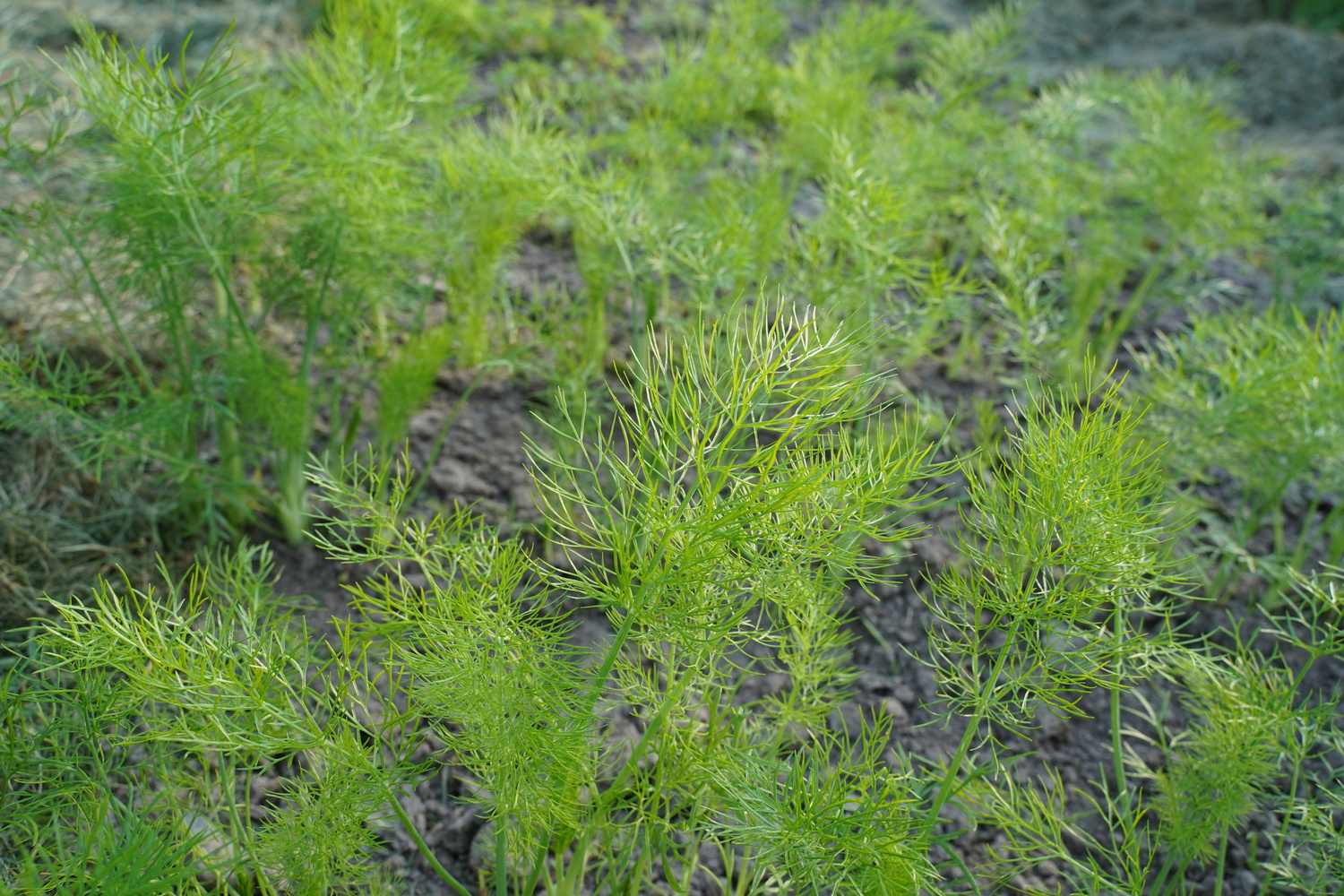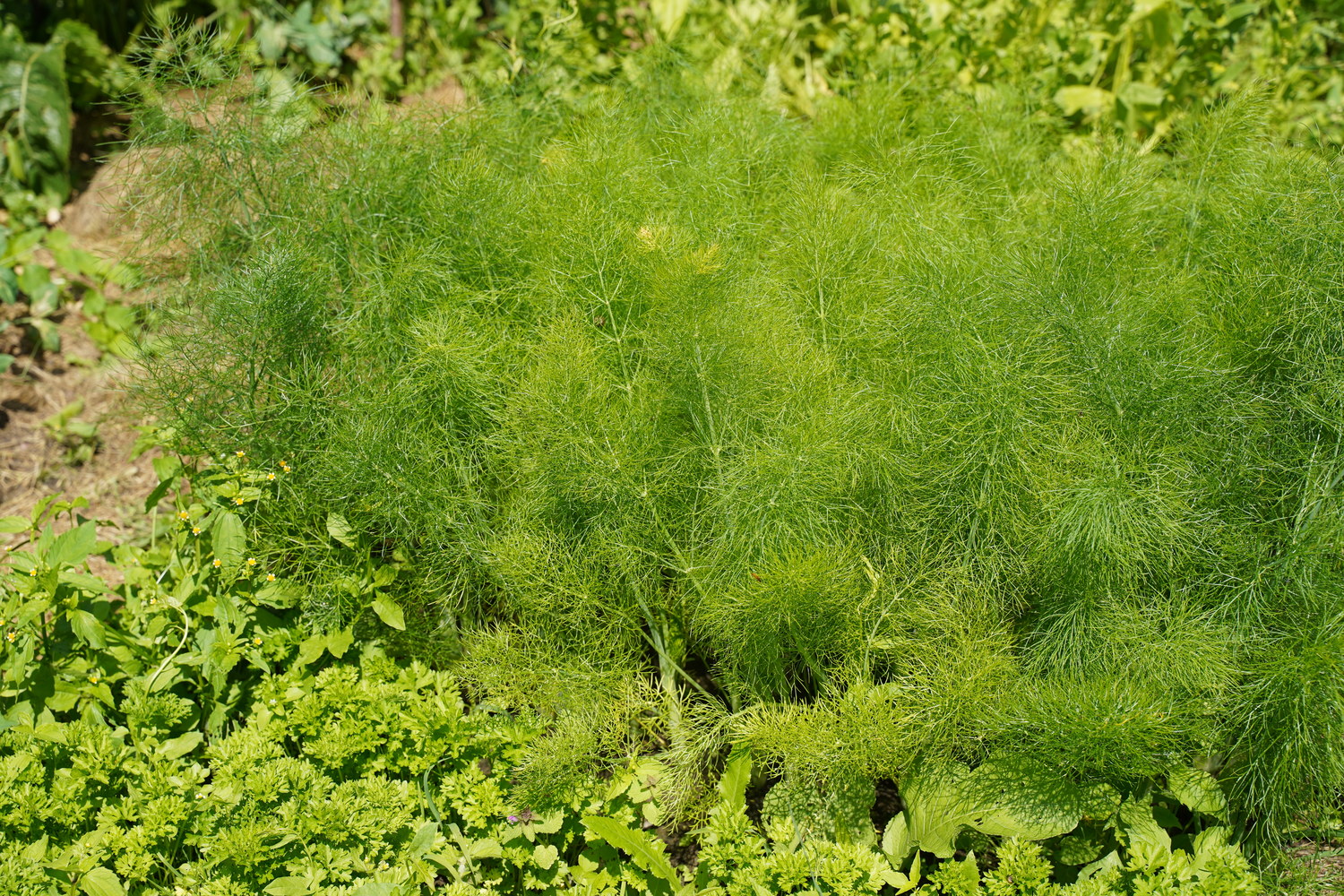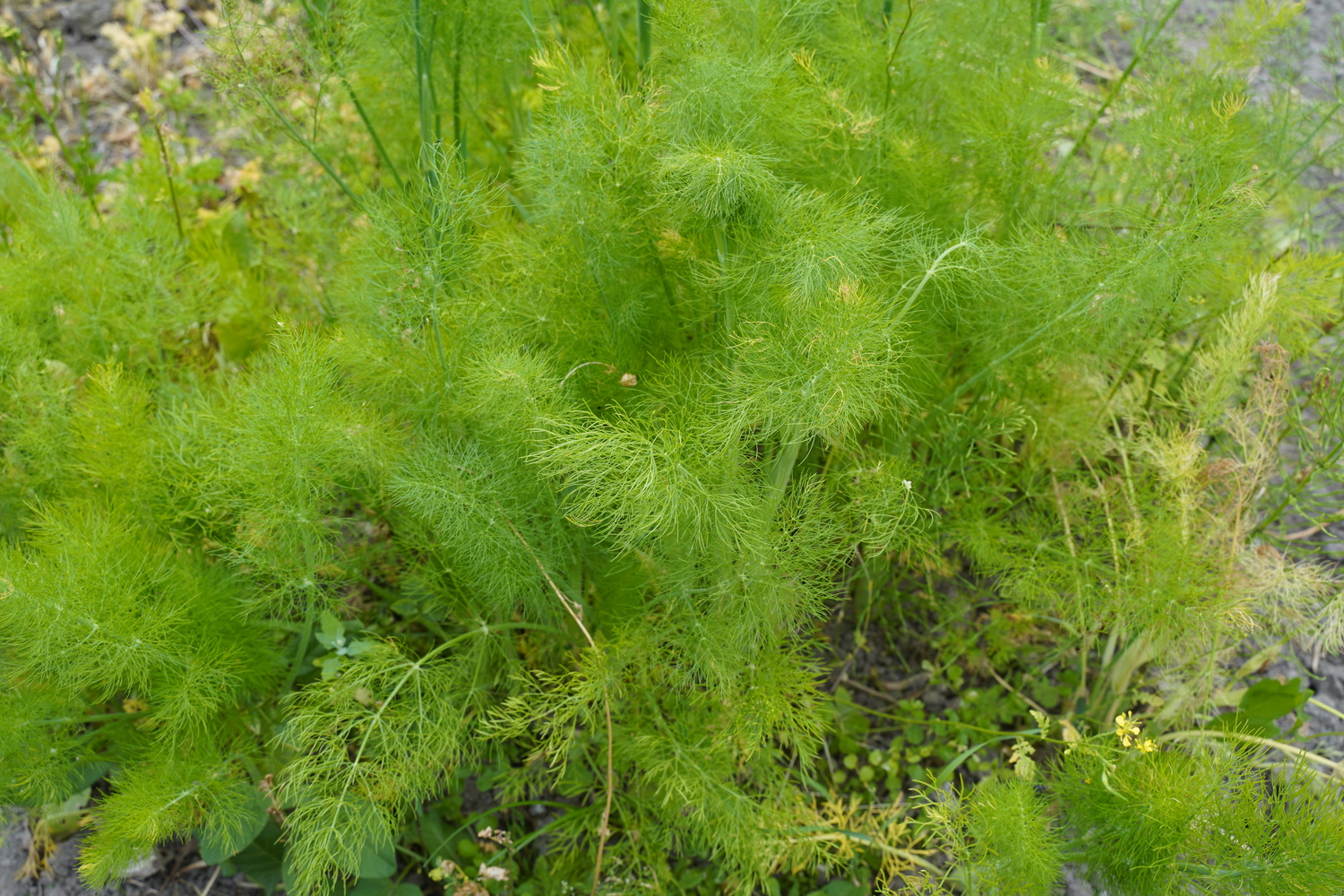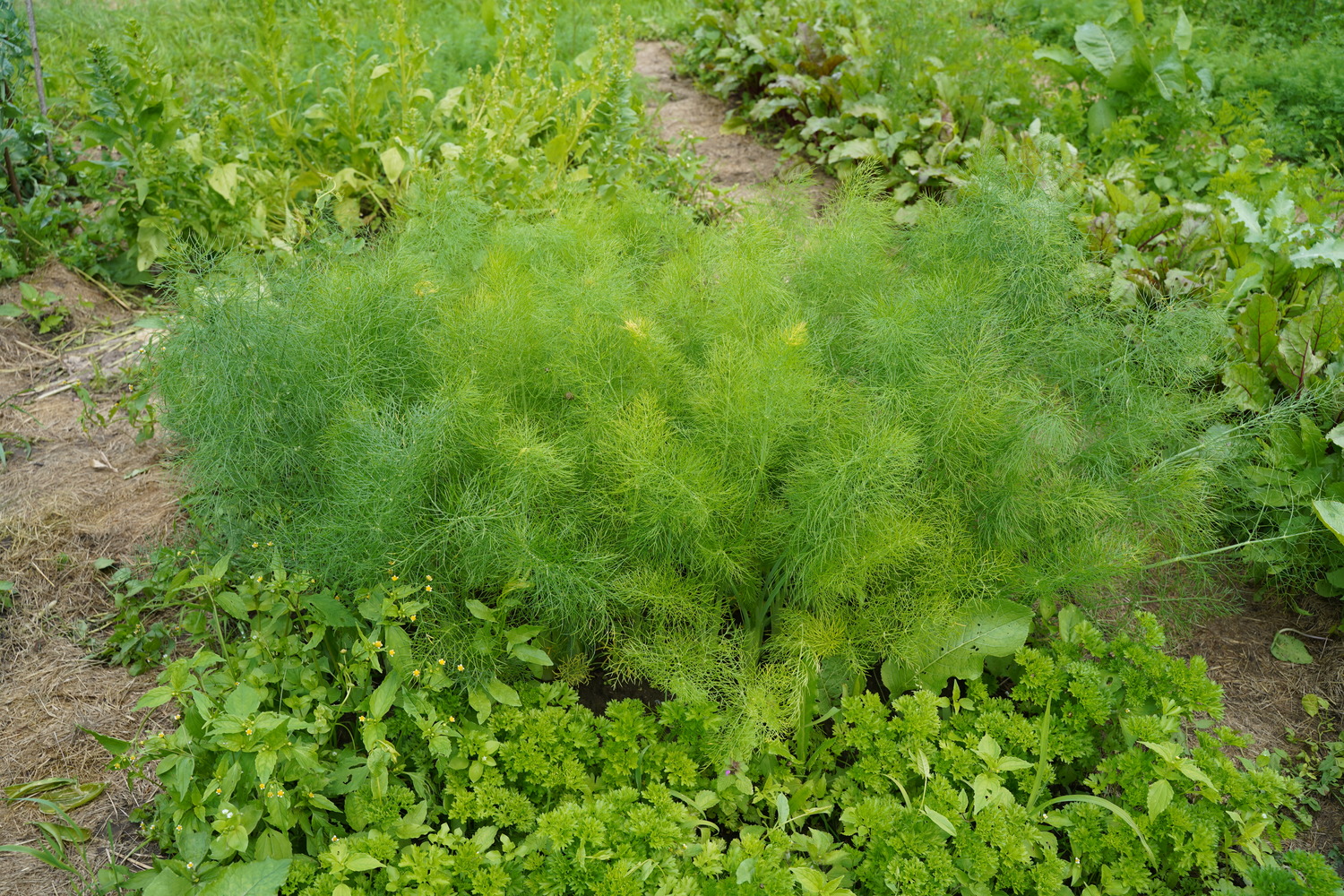Fennel (Foeniculum vulgare) is an aromatic and valuable culinary herb and vegetable, belonging to the celery family (Apiaceae). It originates from the Mediterranean region, where it has been cultivated for thousands of years. Fennel is appreciated not only for its unique flavour but also for its medicinal properties.
Fennel is divided into two main types:
- Leaf (herbal) fennel (Foeniculum vulgare) – a tall, branching plant whose leaves and seeds are used as a spice or medicinal raw material. It is most commonly grown for its greens and aromatic seeds, which are used to make teas, medicinal infusions, and various food seasonings.
- Bulb (vegetable) fennel (Foeniculum vulgare var. azoricum) – this variety develops a thick, fleshy white bulb (an enlarged stem base), which is used as a vegetable. It has a mild, anise-like flavour and is perfect for various dishes – salads, stews, roasting, and even raw food recipes.
Fennel prefers a warm climate, but it can also be successfully grown in cooler regions. Fennel is a perennial, though it is often cultivated as an annual or biennial in areas with cold winters; thus, selecting the right varieties and sowing at the appropriate time is key to producing high-quality bulbs.
Nutritional, Culinary, and Medicinal Properties of Fennel
Nutritional Value and Culinary Uses of Fennel
Fennel is an excellent source of dietary fibre, vitamins, and minerals. It is particularly rich in:
- Vitamins: A, C, E, K, and B-group vitamins (especially B9 – folic acid)
- Minerals: calcium, potassium, magnesium, iron, phosphorus, and zinc
- Essential oils, which give fennel its distinctive anise-like aroma
Bulb fennel has a flavour reminiscent of celery, anise, and parsnip, with a crisp and juicy texture. It can be eaten raw, sautéed, roasted, or added to soups and sauces.
Fennel is most commonly used as a spice - fresh fronds and the seeds add a unique flavour to fish, meat, vegetable dishes, and baked goods.
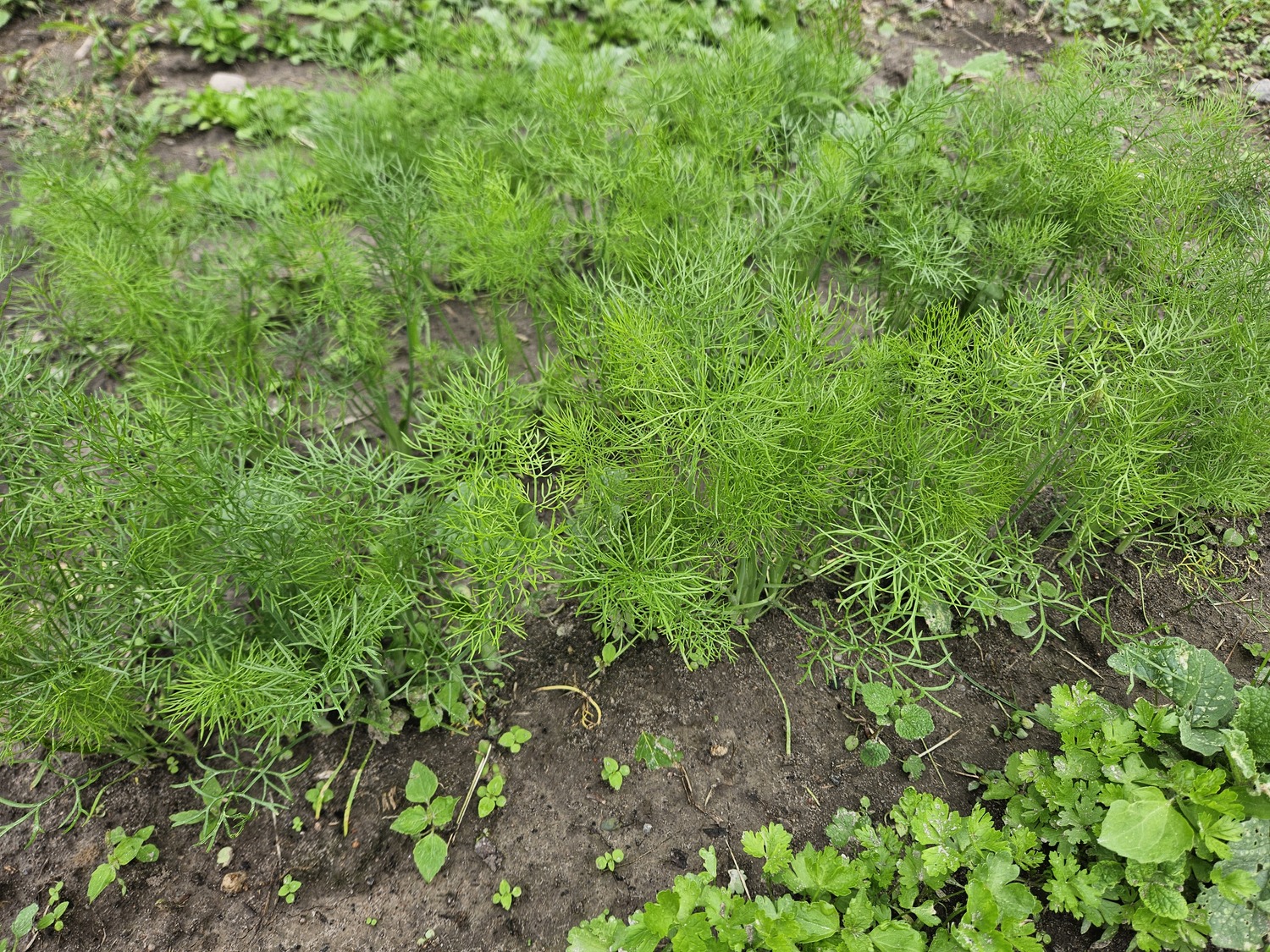
Fennel's Culinary Properties
Fennel seeds are one of the most popular spices in Mediterranean and Asian cuisines. They have a sweet, anise-like flavour and are commonly used in bread, sauces, pickled dishes, and tea. Dried fennel leaves and stems can also be used as a subtle aromatic spice.
Medicinal Properties of Fennel
Fennel has long been valued for its digestive and soothing properties. The essential oils it contains have anti-inflammatory, antispasmodic, and antibacterial effects. Fennel tea is commonly used for:
- Improving digestion by reducing bloating and spasms,
- Clearing the respiratory tract, as it helps with expectoration and reduces mucus buildup,
- Calming the nervous system, which is why it is included in various herbal blends,
- Stimulating lactation, as fennel tea is popular among breastfeeding mothers.
Fennel seeds are also included in various medicinal blends for treating gastritis and digestive disorders.
Location and Soil for Fennel Sowing
Fennel is a warmth-and-sunlight-loving plant, thriving best in open, sunny areas protected from strong winds. It requires good light exposure, as it belongs to the long-day crops—if the daylight is too short, its growth may slow down, and if the daylight is too long, it may enter the flowering stage prematurely, especially if the planting time is not properly chosen. Fennel does not like waterlogged areas, so it is unsuitable for swampy soils or places with high groundwater levels.
When planting fennel, it is important to follow the principle of good companion planting. It pairs well with peas, kohlrabi, cucumbers, cabbage, and potatoes. However, it does not grow well near tomatoes, beans, dill, and carrots, as it may compete with these crops for nutrients. Fennel can be grown in the same location for 2-3 years, but it is recommended to rotate the planting site afterwards to reduce the risk of diseases and pests.

Fennel requires fertile, loose-textured, and well-drained soil. The best soil for fennel is light loam or sandy loam with a neutral ph (6.5-7.0). If the soil is acidic, it needs to be limed. Soil preparation should begin in advance, during the fall, deeply till the beds (up to 30 cm deep) and incorporate organic fertilisers such as compost or well-rotted manure. In the spring, the soil should be loosened and enriched with mineral fertilisers necessary for plant growth and bulb formation.
It is worth watering the furrows before sowing fennel. This way, the seeds will germinate more quickly with increased moisture, while the weed seeds in the surrounding area will sprout later.
Fennel Sowing for Seedlings
Seedlings are typically prepared to grow fennel bulbs. For those starting to grow fennel bulbs, it can be a real challenge. Fennel bulbs form when there is less sunlight and sufficient moisture. Therefore, sowing seedlings and growing them in a greenhouse during the spring allows for the cultivation of high-quality bulbs.
When sowing seedlings, this is typically done in March-April using peat or plastic pots, as fennel roots do not like being transplanted. The seeds are covered with a 0.5 cm layer of soil, as light is required for germination. The optimal germination temperature is 20-25 °C, and the first seedlings appear after 7-10 days. Once the seedlings reach 3 weeks of age and have developed their first true leaves, they should be pricked out. After pricking out, it is recommended to keep the seedlings at 8-10 °C to prevent them from becoming leggy.
When the seedlings reach a height of 10-15 cm and have 3-4 true leaves, they can be planted outdoors, usually in mid-May or early June, when the soil has warmed up sufficiently and there is no risk of frost. When planting, it is essential to leave a 15-20 cm distance between plants and 40-60 cm between rows if growing bulb fennel. If planting leaf fennel, the spacing can be smaller. Since fennel does not tolerate transplanting well, care should be taken not to damage the root system during planting.
Fennel Sowing Outdoors
Fennel can be directly sown into the open ground, but it's important to choose the right time for sowing. For leafy fennel, sowing takes place from mid-April to late July, every 2 weeks, to ensure a continuous harvest. For bulb fennel, seeds are sown at the end of June or in July, when the day length begins to shorten. This helps prevent premature flowering, which would hinder the formation of quality bulbs.
Bulb fennel will turn into leafy fennel if there is a lack of moisture and the conditions are too warm and sunny. The fennel will start to produce flower stalks.
Before sowing, it is recommended to soak the seeds for 12-24 hours to speed up germination. The seeds should be sown at a depth of 1-2 cm in heavy soil and 2-3 cm in light soil. Leave a 40 cm distance between rows and 15-20 cm between seeds when growing bulb fennel. After 10-15 days, once the seedlings have emerged, they need to be thinned, leaving only the strongest plant every 15-20 cm.
Fennel Fertilisation and Care
Fennel is quite demanding in terms of nutrients, but excessive amounts of organic fertilisers should be avoided, as too much can encourage excessive green mass growth and slow down bulb formation. Organic fertilisers (compost, well-rotted manure) should be incorporated into the soil in the fall, but they should not be applied right before planting.
In spring, fennel requires mineral fertilisers. The first fertilisation is done during the 3-4 true leaf stage, adding 10-12 g of ammonium nitrate, 20-25 g of superphosphate, and 10-12 g of potassium salt per m². If fennel is grown for seeds, a second fertilisation is done during the formation of flower stalks, using 10 g of ammonium nitrate and 5-8 g of superphosphate per m². Finally, to ensure proper fruit ripening, 2 g of phosphorus fertilisers per m² of moist soil are incorporated before the final harvest.
Fennel care is not difficult, but to ensure a high-quality harvest, it is important to continuously manage soil loosening, weed control, watering, and hilling.
The soil around fennel should be regularly loosened to ensure good air circulation to the roots. During the growing season, the soil is recommended to be loosened 2-3 times, starting immediately after germination. Weeds should be removed by hand or by lightly cultivating the spaces between rows.
Watering must be regular and abundant, especially during dry periods. A lack of water can cause early flowering, which prevents bulb formation. Fennels should be watered 2-4 times during the season, using 15-20 litres of water per square meter. If the soil is light, watering can be done more frequently, but with smaller amounts.
When the fennel starts to form its bulb, it is very important to hill it up. This helps protect the plant from excessive sun exposure, retains moisture, and gives the bulb a softer texture. Hilling should be done when the bulb reaches 5-7 cm in diameter.
Pests and Diseases of Fennel
Fennel is not resistant to diseases and pests, so it is important to regularly monitor the plants and ensure proper prevention.
The main pests include May beetle larvae that can damage fennel seedlings and young plants, as well as aphids, thrips, and swallowtail caterpillars. The most dangerous pests are the umbrella-shaped and striped bugs, the coriander seed borer, and the umbrella moth, which damage the leaves and seeds.
The main diseases: Fennel can suffer from Fusarium, which is especially dangerous when growing fennel for seeds. The symptoms of this disease appear in mid-summer, with small spots and patches appearing on the leaves and stems. If the disease spreads, by September-October, the plant completely dries out, and the seeds fall off before they fully mature.
Disease and pest prevention: The primary control method is proper crop rotation, timely removal of plant debris, and optimal planting density to ensure good air circulation. Since fennel is usually grown as a culinary and medicinal plant, the use of chemical treatments is limited.
Fennel Varieties
Different varieties of fennel differ in terms of ripening time, plant size, and bulb characteristics. Many gardeners purchase seeds from Russia, where there is a wider selection of fennel varieties. Sellers often advertise their seeds on gardening forums.



